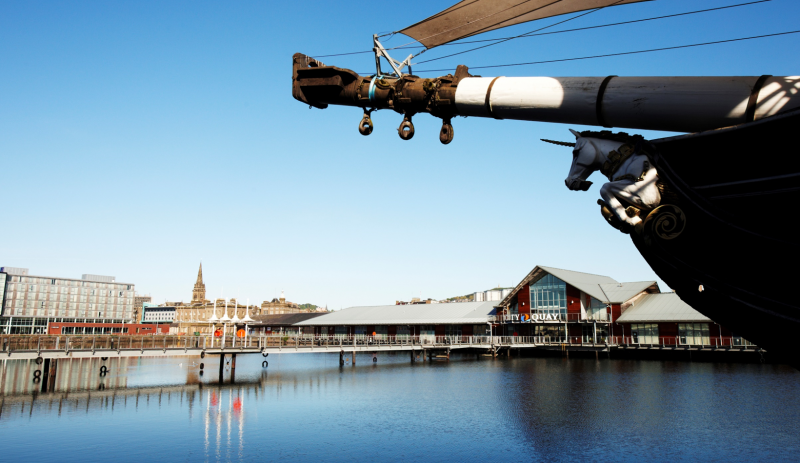A trip back in time in Dundee

Posted : 4 October 2019
Dundee has a wealth of vibrant and interesting historical landmarks and locations for history fans to visit, ranging from our massive involvement in the jute industry, shipbuilding industry, journalism and our history of pioneering and exploration.
Dundee is home to one of the world’s oldest surviving ships, the sixth oldest in fact, HMS Unicorn, which was a Royal Navy frigate built and launched in 1824. In 1873 she was moved to Dundee, remaining a training vessel for the navy and also serving as a command/ headquarters vessel for senior Royal Navy officers during both the first and second world wars.
Visitors can explore the 46 cannon gun deck, the crew’s sleeping quarters, the grand and plush officer’s mess at the stern of the ship as well as the gallery and gift shop on the vessel's upper decks.
Following the nautical theme, Dundee is also home to RRS Discovery, an Antarctic exploration vessel built and launched in the city in 1901. The Discovery is the last traditional wooden, three mast vessel to be constructed by the UK and following a successful expedition to the Antarctic, the Discovery was put into service as a merchant ship, before becoming the first Royal Research Ship put into service by the United Kingdom. Discovery is one of two surviving Antarctic exploration ships, the other being the Norwegian ship, “Fram”.
Upon boarding the ship, guests have the opportunity to see how Captain Scott and his crew lived, how they survived and what the hardships and the triumphs of their voyage were. There is a café and gift shop at Discovery Point, onshore, for visitors to enjoy.
For many years, Dundee was the world hub for jute, a cheap yet tough material ideal for packing produce, such as sugar, wool, coffee and other imported goods. This material had a worldwide reach, being necessary for trade, for the production of sandbags and other military requirements as well as protective coverings for lorries etc.
Verdant Works is a surviving jute mill which now serves as a museum. Visitors can explore what a mill was like in the late 19th and early 20th Century, and see the way in which almost half Dundee’s population lived and worked. Many of the workers were female, which was unusual for the time. The unemployed men who stayed at home gained the name “kettle bilers” (kettle boilers).
Broughty Castle and its grounds date back to the 15th Century, and was a fortified location during the War of the Rough Wooing, following the 1547 battle if Pinkie in which it saw military action. The castle has seen many battles and sieges and was rebuilt and used as a defensive positon as late as the 19th century.
Today, Broughty Castle museum houses displays on the life of Broughty Ferry and its citizens, the wildlife, nature and environment of Broughty Ferry and the surrounding area and the Orchar Gallery, which hosts a number of paintings and other art pieces. There is also a gift shop to browse and refreshments to enjoy.
Claypotts Castle was the fortified residence of the Strachan family, between the years of 1569 and 1588. The castle has been very well maintained, and is one of the few Scottish castles to be in no state of degradation at all. The castle grounds are free to explore all year round, however, access to the castle’s interior has to be pre-arranged.
For an overall view of Dundee’s history, The McManus is Dundee’s Art Gallery and Museum, and is home to eight galleries, which hold a diverse selection of exhibits and artefacts, ranging from objects from the time of early man in the area, to objects from industries past and present.
The McManus offers visitors a comprehensive and fascinating journey through 400 million years of Dundee’s history, transforming from a tiny settlement to the heavily industrialised world capital of jute and now the trailblazing, innovative city it is today.
Like Dundee, its surrounding area is rich with history, both ancient and recent. The fascinating ruins of a fortified ditch and towers at Gask Ridge, Killiecrankie predates the iconic Hadrian and Antonine Walls which were constructed by the mighty Roman Empire.
Visitors to Montrose can visit the Air Station which is the first military air station to be established within the United Kingdom, being home to the Royal Flying Corps in 1913. The Air Station has an assortment of artefacts and photographs which help tell the story of the RCF and RAF and the servicemen and women who served at the station during both WW1 and WW2.
In Crail you can visit Scotland’s (not so) Secret Bunker, which was built during the crisis and paranoia of the Cold War to protect Scotland’s leaders and continue their governance in the event of a nuclear attack by the Soviet Union, which provides a grim, yet intriguing insight into nuclear war, but also how close to home this threat was and how “imminent” it was perceived to be during the four-decade long conflict.

by Kerr Boyle
.


